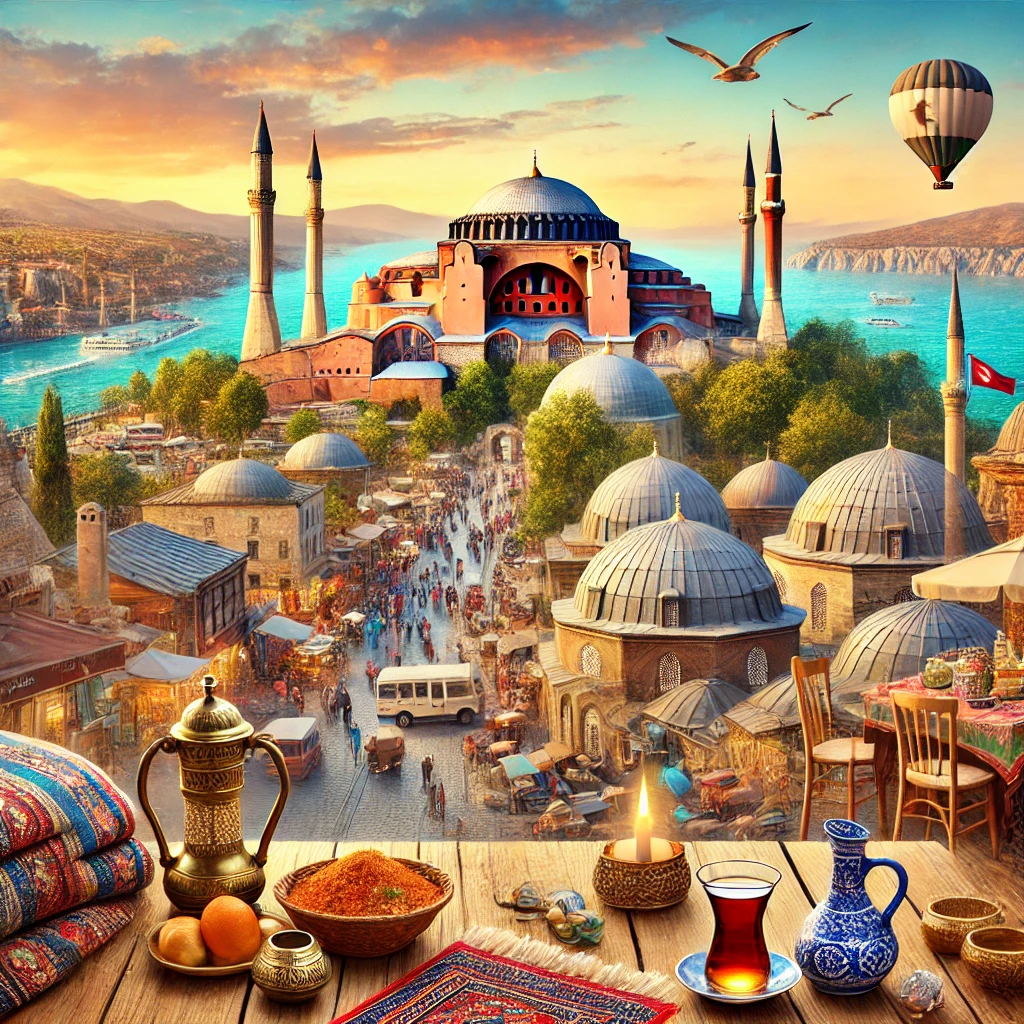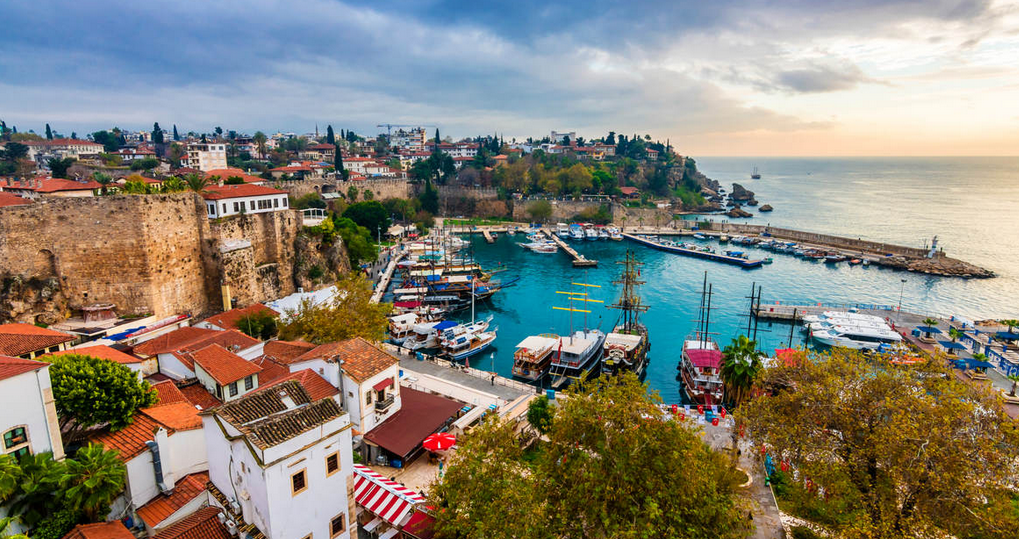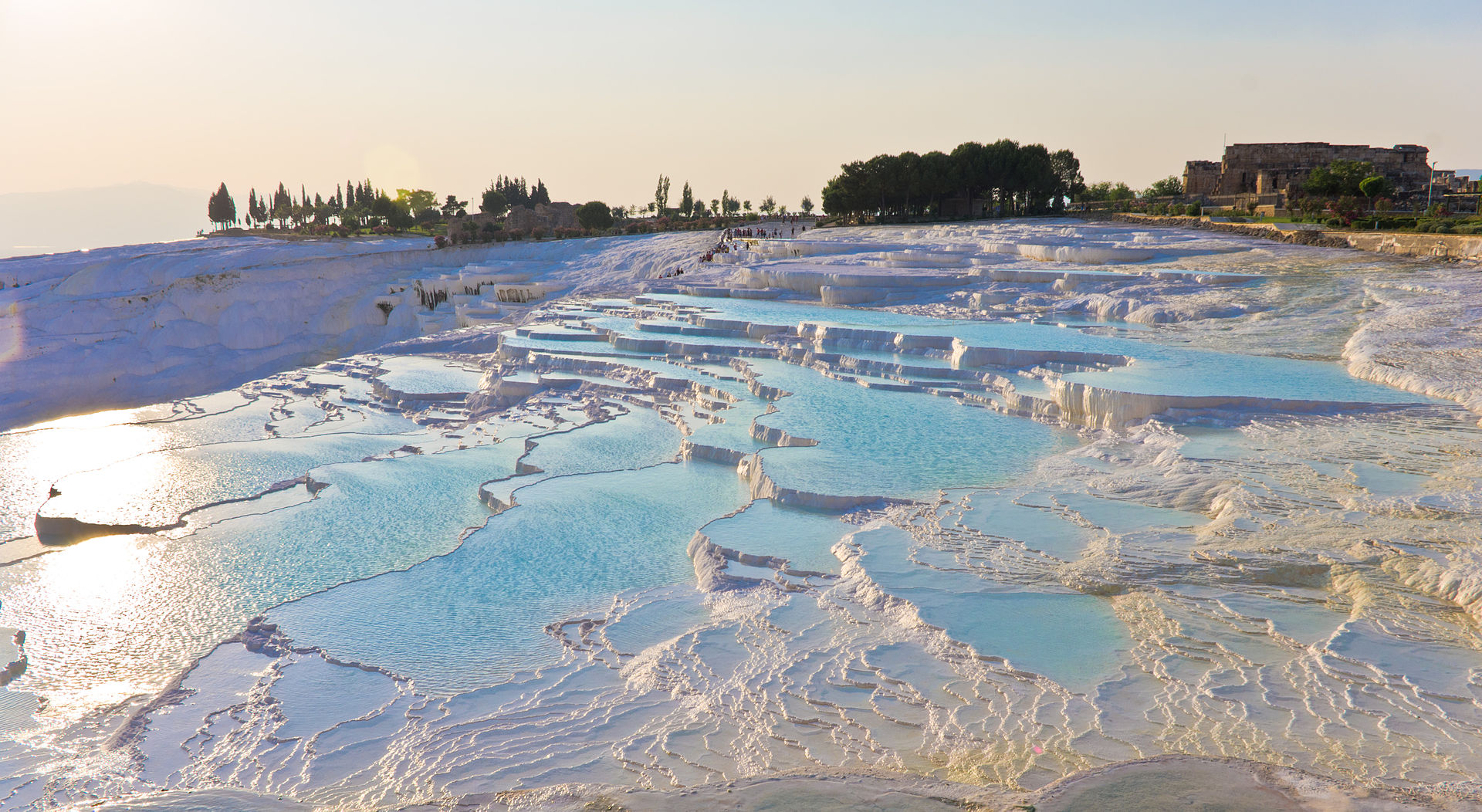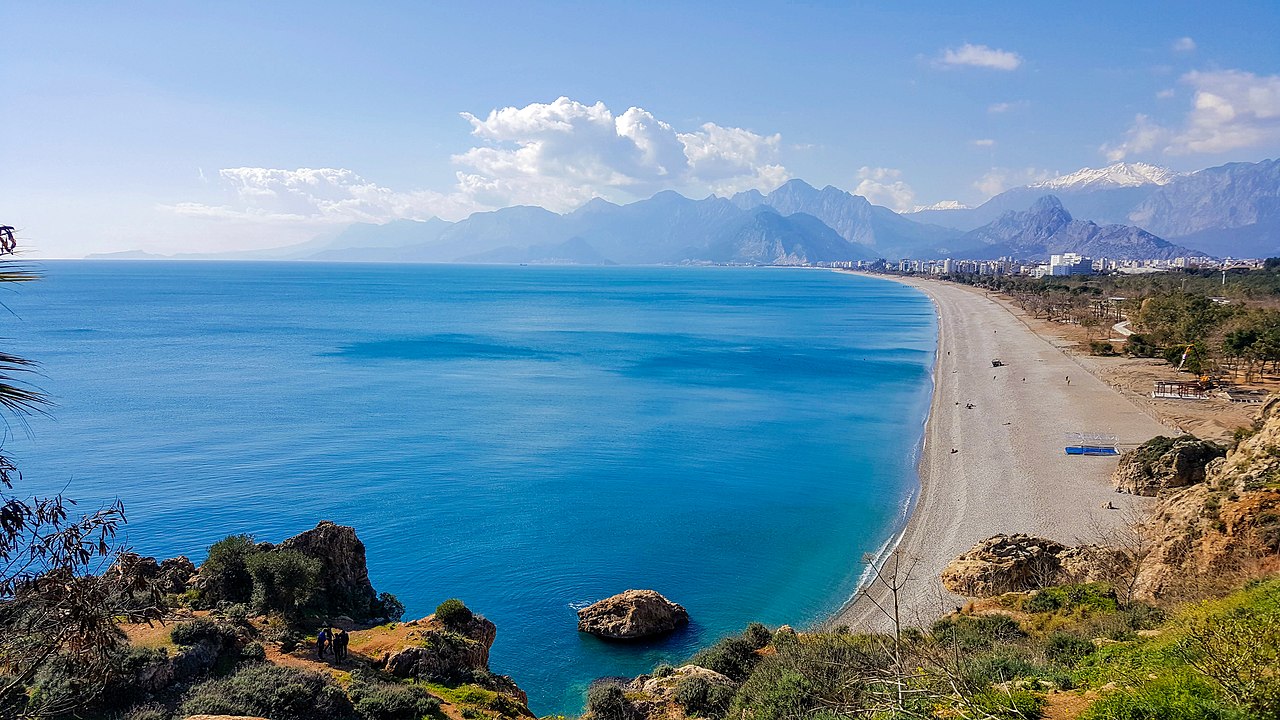
Book Hotel in Cappadocia | Cheap Flights to Nevsehir for Cappadocia Turkey
Fast Link: Book Underground City Tour
Goreme, Urgup, Ihlara Valley, Derinkuyu Underground cities are the top places to visit in Cappadocia. You should see a lot of underground cities around Cappadocia Turkey.
Goreme
Goreme which have the old names of Korama, Matiana and Maccan is 10 km far away from the center of Nevsehir province. You will see a lot of Cappadocia Caves in Goreme. The valley created from volcanic rocks is famous with the chimney rocks resulting from the erosion made by the natural factors to these rocks and with the historical richness. Goreme has been an important religious place together with the intensive emigration of the first Christians escaping from the pressure of the Roman soldiers. The population escaped from the pressures has made many abbeys, churches and houses in the volcanic rocks from the valley where they were able to hidden easily.  In our days in Goreme are found Elmali Church, Saint Barbara Church, Carikli Church, Tokali Church and Hidden Church and all of these are Goreme Open Air Museums. In the churches of Goreme, there are scenes from the life of Jesus, descriptions of the saints who written the Bible and pictures of Saint Barbara and Saint Georgius.
In our days in Goreme are found Elmali Church, Saint Barbara Church, Carikli Church, Tokali Church and Hidden Church and all of these are Goreme Open Air Museums. In the churches of Goreme, there are scenes from the life of Jesus, descriptions of the saints who written the Bible and pictures of Saint Barbara and Saint Georgius.
Urgup
Ürgüp which has been established at the outskirts of the hill named as hill of whishes founded at 20 km in north of Nevsehir province in one of the first settlement areas of Cappadocia region where there are lots of Cappadocia Caves. In the Byzantine period has been called as Osiana, Hagios, Prokopios, in the period of Seljuks as Bashisar and in the period of Ottomans as Burgut Castle. Until the first years of the Republic was called Ürgüp. Ürgüp was the patriarchate center of the Cappadocia region. The Üzümlü Church, Cambazli Church and Sarica Church in Ortahisar which was one of the villages of Ürgüp are the oldest rock churches from the region. Furthermore and Tavsanli Church and Church of Saint Basileious are the spectacular places.  Ürgüp which has got the famous cave hotels, wines and hand made carpets is the most important tourism center of the Cappaddocia Region. The old cave houses were restored as a touristy cave hotel without damaging their historic structure. Among the cave hotels some of the cave have been restores as distraction place as discos and bars.
Ürgüp which has got the famous cave hotels, wines and hand made carpets is the most important tourism center of the Cappaddocia Region. The old cave houses were restored as a touristy cave hotel without damaging their historic structure. Among the cave hotels some of the cave have been restores as distraction place as discos and bars.
Underground cities – Cappadocia Caves
Derinkuyu Underground
Derinkuyu is situated 29km from Nevsehir, on the road to Nigde. The settlement is approximately 85m deep. Derinkuyu Underground City contains all the usual rooms found in an underground settlement (stables, cellars, refectories, churches, wineries etc.). Apart from these, a large room with a barrel vaulted ceiling on the second floor was a missionary school, the rooms to the left being study rooms.
From the 3rd and 4th floors onwards the descent is by way of vertical staircases which lead to the cruciform plan church on the lowest floor of Derinkuyu Underground City.
The 55m deep ventilation shaft was also used as a well. Not every floor was provided with a well, however, some wells of Derinkuyu Underground City were not connected with the surface in order to protect the dwellers from poisoning during raids. Derinkuyu Underground settlement was opened to visitors in 1965, but so far only 10% can be visited.
Kaymakli Underground
 This underground settlement which is located in the centre of the village of Özlüce, the ancient name of which was Zile, is on the Nevsehir-Derinkuyu road, 6 km south of the town of Kaymakli.
This underground settlement which is located in the centre of the village of Özlüce, the ancient name of which was Zile, is on the Nevsehir-Derinkuyu road, 6 km south of the town of Kaymakli.
Ozluce Underground settlement is different from the others in terms of its geological formation and architectural features. The underground settlement has tufa of different colors. There is only one floor in this underground settlement which has not been completely opened; however, it covers a very large area.
At the entrance is a place with two intertwining arches made of basalt. Access to the main tufa stone can be gained through a 15 m long passage, made of rubble stone. The stone places, which lead to the underground settlement, are more recent than the rock hollowed places that form the underground settlement. At the end of this passage there is a millstone door which is made of hard granite and is 1.75 m in diameter.
Being the largest area in the underground settlement, the main space at the entrance consists of two parts. To the right of the main space are storage rooms, and to the left are living areas. On the sides of the long corridors are cell-like rooms and on the floor are traps.
Ozkonak Underground
This underground settlement is in the center of the town of Ozkonak, 14 km north of Avanos and hollowed out into the west slopes of the Idis Dagi ,where the tufa layers are mainly found.
Although there is only one floor, it covers a large area and the spaces are connected to each other with tunnels. Unlike the important underground cities of Kaymakli and Derinkuyu, there are very long and narrow holes to enable communication between the levels. When the entrances of neatly hollowed chambers were closed, those narrow (5 cm in diameter) and long holes were used also for ventilation.
Unlike the other underground settlements, just in front of the millstone doors, on the ceiling of the tunnels, there are small holes which were made to pour hot oil on the enemy, or to spear them.
As in the underground cities of Kaymakli and Derinkuyu, in this underground settlement are a ventilation shaft, a well, a winery and millstone doors.
Ozluce Underground
This underground settlement which is located in the centre of the village of Ozluce, the ancient name of which was Zile, is on the Nevsehir-Derinkuyu road, 6 km south of the town of Kaymakli.
Ozluce Underground settlement is different from the others in terms of its geological formation and architectural features. The underground settlement has tufa of different colors. There is only one floor in this underground settlement which has not been completely opened; however, it covers a very large area.
At the entrance is a place with two intertwining arches made of basalt. Access to the main tufa stone can be gained through a 15 m long passage, made of rubble stone. The stone places, which lead to the underground settlement, are more recent than the rock hollowed places that form the underground settlement. At the end of this passage there is a millstone door which is made of hard granite and is 1.75 m in diameter.
Being the largest area in the underground settlement, the main space at the entrance consists of two parts. To the right of the main space are storage rooms, and to the left are living areas. On the sides of the long corridors are cell-like rooms and on the floor are traps
Tatlarin Underground
 The village of Tatlarin, located 10 km north of the town of Acigol, is one of the interesting places in Cappadocia because of both its underground settlement and churches and the architecture of its houses. Its underground settlement, located on the hill called ‘the castle’ by the locals of the village, was first discovered in 1975 and opened to the public in 1991. The size of the chambers in the underground settlement, only two floors of which can be visited; the presence of the toilets, which also can only be found at the Guzelyurt Underground Settlement; the abundance of the depots for food and of the churches make one think that this place was either a garrison or a monastic complex rather than an underground settlement.
The village of Tatlarin, located 10 km north of the town of Acigol, is one of the interesting places in Cappadocia because of both its underground settlement and churches and the architecture of its houses. Its underground settlement, located on the hill called ‘the castle’ by the locals of the village, was first discovered in 1975 and opened to the public in 1991. The size of the chambers in the underground settlement, only two floors of which can be visited; the presence of the toilets, which also can only be found at the Guzelyurt Underground Settlement; the abundance of the depots for food and of the churches make one think that this place was either a garrison or a monastic complex rather than an underground settlement.
The Tatlarin Church
The church is on the slope of the hill, called “the castle”, in the town of Tatlarin, about 10 km north of Acigol. The narthex of the church, which has two naves and two apses, is collapsed. The well preserved scenes are separated from each other with dividers. The background is dark gray whereas with figures colors like purple, mustard color and red are used.
Scenes: On the apse Mother Mary and Baby Jesus, Archangels Michael and Gabriel; Constantine the Great and Helena, Transfiguration, Anastasis, Entry into Jerusalem, Crucifixion and portraits of 9 saints as well as the donor’s.
Saruhan
It is located in the valley of Damsa, 5km southeast of the town of Avanos in the vicinity of Nevsehir and 6 km north of Ürgüp. The han is on the Aksaray-Kayseri route in the east-west connection.
Saruhan, built during the reign of Izzettin Keykavus I -maybe upon his orders- in 1249, covers an area of 2000 m square. Yellow, reddish pink and light brown regular stone blocks were used as building material in Saruhan.
A decorative look was achieved by using stone of two different colours in the arches of both the monumental portal and the inner portal. In the outer portal, the upper parts of which partly collapsed, mainly geometrical decorations were used like in the other sultanhans. Its domed mescid, unlike other caravanserais, was built above the monumental portal. The doorway of the mescid, facing the courtyard, is decorated with squinches with mukarnases. To the left of the large courtyard is a portico with a fountain and to the right are the places for accommodation and bathing. The small lines on some of the stones used in the porticoes are stonemasons’ marks. The hall where animals and their keepers stayed is similar to the ones in Aksaray Sultanhan and Agzikarahan. The oculus, seated on pendentives is quite plain.
The Han, the upper parts of which have collapsed in places, was returned to its original state with the completion of its restoration in 1991. After Saruhan, one of the latest examples of Sultahhans, the Seljuk Sultans did not have hans built.
Ihlara Canyon
This valley is situated 40km from Aksaray and can be reached making a turn at the 11th km of the Aksaray-Nevsehir road.
The canyon was created by the cracking and collapsing which occurred as a result of basalt and andesite lava from Mt. Hasandag’s eruption. The Melendiz river found its way through these cracks, eroding the canyon bed and helping to form canyon we see today. The Melendiz river used to be called “Potamus Kapadukus”meaning the River of Cappadocia.
The 14km long, 100 -150m high valley begins at Ihlara and ends at Selime. There are numerous dwellings, churches and graves built into the valley walls, some of which are connected by tunnels and corridors.
The valley proved to be an ideal place for the seclusion and worship of monks, and a hideaway and defense area for people during times of invasion.
The decorations in the churches can be dated to various times from the 6th to the 13th centuries, and the churches can be classified into two groups. The churches near to Ihlara display frescoes with oriental influence. Those nearer to Belisirma display Byzantine type decorations.
Very few Byzantine inscriptions in this area can be read. Above a 13th century fresco in the church of St. George (Kirkdamatl), the names of Seljuk Sultan Mesud II (1282 – 1305) and the Byzantine Emperor Andronicos II are inscribed. This is proof of the tolerance of the Seljuk rulers. The best preserved frescos are to be found in the churches of Agacalti, Purenliseki, Kokar, Yilanli and Kirkdamatli.
Book Hotel in Cappadocia | Cheap Flights to Nevsehir for Cappadocia Turkey





